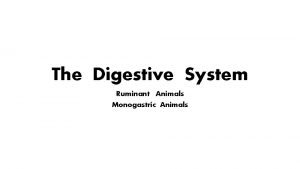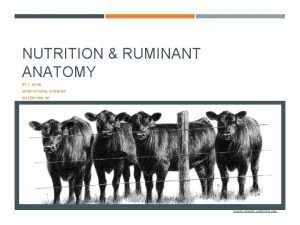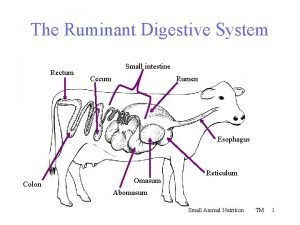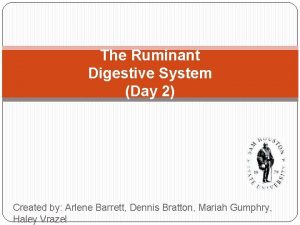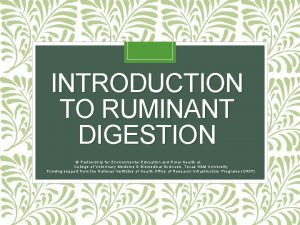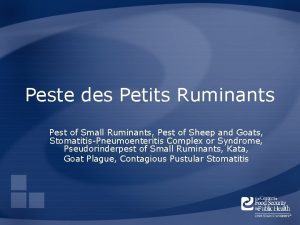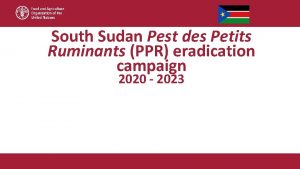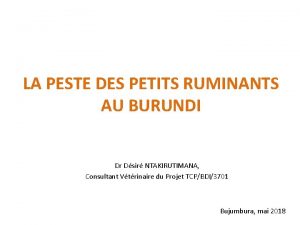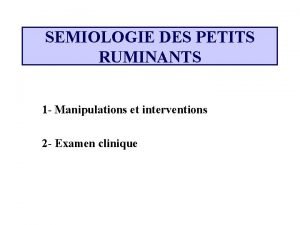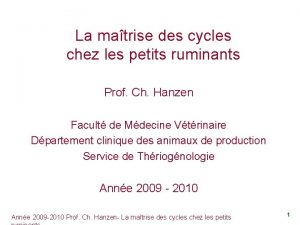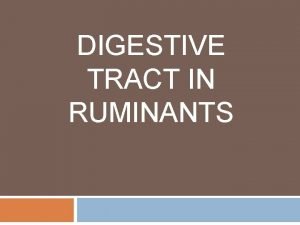Comparison of Peste des petits ruminants PPR disease










- Slides: 10

Comparison of Peste des petits ruminants (PPR) disease between Tanzania and Kenya C. G. Gitao S. M. Kihu, L. C. Bebora, J. M. Njenga, G. G. Wairire N. Maingi, Muse E. A. Karimuribo E. D. , Misinzo G. , L. S. B. Mellau, Msoffe P. L. M, Swai. E. S. and Albano M. O.

PPR Disease PPRV has been classified into four lineages that are distinct to different geo-graphical locations based on variable nucleotide sequences of the nucleoprotein (N) gene. Western and Central African PPRV cluster into Lineages I and II, Eastern African and PPRV found in the southern part of Middle East cluster into Lineage III while Asian PPRV mainly cluster into Line-age IV

Data collection 2011 Kenya- data collection Tanzania sample collection

PPR in Kenya • First suspected in Kenya, 1992, 1995 • Clinical Cases in 2007 -8 • Survey in 2011 -Turkana

Post mortem Kenya-Turkana 2011 Hepatized apical lobe; Swollen mesenteric lymph nodes Samples were positive by reverse transcriptase RNA. The positive samples were sequenced and identified as belonging to peste des petits ruminants virus (PPRV) lineage III. Fullgenome analysis of one of the positive samples revealed that the virus causing disease in Kenya in 2011 was 95. 7% identical to the full genome of a virus isolated in Uganda in 2012 and that a segment of the viral fusion gene was 100% identical to that of a virus circulating in Tanzania in 2013.

Tanzania- Muse 2011 • Serological evidence of PPR in Ngorongoro 2004 • PPR first reported outbreaks in Tanzania in 2008 in the Northern Zone districts bordering Kenya. • 2011 Tandahimba and Newala- History of recently purchased live animals- from Pugu live goat market • No history of vaccination • High prevalence in adults as compared to young • Fever, Discharges, reddening of conjunctiva, Matting of eyelids; respiratory distress and coughing Ulcers were found on soft and hard palates, on nose, lips and face Diorrhoea, respiratory • Extensive nodules all over the body: were firm, freely movable with the skin, and were not painful on palpation

PPR 2011 Tandahimba zz • Abortions in two goats reported • Orchitis and posthitis were noted in animals with ulcerated nodules on the scrotum and prepuce respectively. • Lesions more severe in goats than sheep. Data collected from the study area in Tandahimba district showed 73. 1%, 37. 4% and 51. 2% disease morbidity, crude mortality and case fatality percentages respectively • Low sero-prevalence rates- 31% • Little GIT involvement[ severe respiratory involvement – severe consolidation of the lung parenchyma Lungs showed increased thickness of inter-alveolar walls, infiltration of mononuclear cells and moderate number of neutrophils in the alveolar walls and bronchiolar sub-epithelial layer

PPR Manifestation Lineage II and IV PPRV strains from Tanzania were clustered in two distinct lineages. One group of Tanzanian strains clustered within lineage IV with previously characterized strains from Middle East Another strain clustered within lineage II, a lineage desribed in Uganda and showed 98% identity with a virus from Nigeria (Nig/75/1), which is used as vaccine virus strain in many countries. Tanzania-Tandahimba & Newala Districts

Tanzania Ngorongoro(N) and Movomero(E) 2013 Kgotlele et al. , • Samples obtained from live goats with clinical presentation suggestive of PPR and goats that died naturally in Ngorongoro (Northern Tanzania) and Mvomero (Eastern Tanzania) districts. • Typical clinical signs and postmortem • Phylogenetic analysis, based on the N gene, indicated that PPRV obtained from Northern and Eastern Tanzania clustered with PPRV strains of Lineage III,

• Insecurity Challenges Mobile research unit • Difficult terrain




